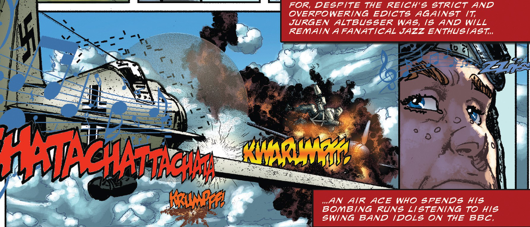War Is Hell #1 // Review
Back in the 1970s Marvel published a short-lived title called War is Hell. Initially it was a reprint of old stories from an era in the 1950s when Marvel was known as Atlas Comics. This month, Marvel celebrates its 80th birthday with a title paying homage to a title that originally paid homage to 1950s war anthology with titles like Battle, Battle Action, Battlefield and War Action. It’s a two-story issue featuring work by writer/artist Howard Chaykin, writer Phillip Kennedy Johnson, artist Alberto Alburquerque and colorists Edgar Delgado and Andres Mossa.
The opening story is Chaykin’s “Swing Verboten!” Chaykin is a seasoned veteran of comics having been working in the field for nearly half a century. He’s done a tremendous amount of work over the years. (He once even did work for Weird War Tales--a DC comics precursor to Marvel’s original War Is Hell.) In this issue, Chaykin is a master working with a simple premise: Jazz was prohibited by the Nazis so...what would have been like for a German fighter pilot who loved jazz? Chaykin uses the springboard for a delightfully tight, little 10-page story that has the weight and tempo of something that might have appeared in an old EC war anthology comic. There’s a tight delivery of premise and a razor-sharp follow-through that ends in kind of a darkly glib punchline. Chaykin’s art style feels as fresh as ever as he delivers a remarkably fun, little WWII period piece. Edgar Delgado’s coloring on the story feels like a slightly more richly rendered version of Steve OIliff’s beautiful colors in Chaykin’s 1987 WWII-based Blackhawk: Blood & Iron series for DC.
The second story “War Devil” echoes the supernatural feeling that the original War Is Hell adopted towards the end of its short run. A US soldier who served in Afghanistan encounters a vengeful African spirit that passes from body to body via blood at the time of death. Philip Kennedy Johnson has the entire story rendered quite well in the first-person narration of the protagonist. The art layered over the monologue is not the best work of talented Spanish artist Alberto Jimenez Alburquerque. The complex mechanics of his style are better matched with a more expressly-rendered narrative. The stoic conversational poetry of Philip Kennedy Johnson’s narrative would be better suited to dark, hauntingly static images moving the eye from one box of narration to the next. Andres Mossa’s art is a stylish stain across the top of it all in muted moody colors.
The poorly-matched creative team on the second story is overshadowed by a casually clever, little 10-pager by a seasoned master in the opening issue of an all-new anthology series. It’s refreshing to see a couple of simple short one-shot stories with throwaway characters in a mainstream comic book rack filled with complex long-running serials with backstories that continue to get more and more convoluted over time. A series like this really has the opportunity to showcase the work of individual artists whether they be legends like Chaykin or rising unknowns looking to prove themselves.







